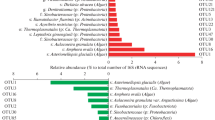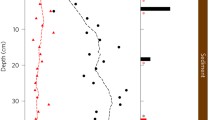Abstract
The build-up of methane in the hypolimnion of the eutrophic Lake Rotsee (Lucerne, Switzerland) was monitored over a full year. Sources and sinks of methane in the water column were characterized by measuring concentrations and carbon isotopic composition. In fall, high methane concentrations (up to 1 mM) were measured in the anoxic water layer. In the oxic layer, methane concentrations were much lower and the isotopic composition shifted towards heavy carbon isotopes. Methane oxidation rates peaked at the interface between oxic and anoxic water layers at around 8–10 m depth. The electron balance between the oxidants oxygen, sulphate, and nitrate, and the reductants methane, sulphide and ammonium, matched very well in the chemocline during the stratified season. The profile of carbon isotopic composition of methane showed strong indications for methane oxidation at the chemocline (including the oxycline). Aerobic methane oxidizing bacteria were detected at the interface using fluorescence in situ hybridization. Sequencing the responsible organisms from DGGE bands revealed that aerobic methanotrophs type I closely related to Methylomonas were present. Sulphate consumption occurred at the sediment surface and, only towards the end of the stagnation period, matched with a zone of methane consumption. In any case, the flux of sulphate below the chemocline was not sufficient to oxidize all the methane and other oxidants like nitrate, iron or manganese are necessary for the observed methane oxidation. Although most of the methane was oxidized either aerobically or anaerobically, Lake Rotsee was still a source of methane to the atmosphere with emission rates between 0.2 mg CH4 m−2 day−1 in February and 7 mg CH4 m−2 day−1 in November.








Similar content being viewed by others
References
Barker JF, Fritz P (1981) Carbon isotopic fractionation during microbial methane oxidation. Nature 293:289–291
Bastviken D, Cole J, Pace M, Tranvik L (2004) Methane emissions from lakes: dependence of lake characteristics, two regional assessments, and a global estimate. Global Biogeochem Cycles 18:GB4009. doi:10.1029/2004GB002238
Beal EJ, House CH, Orphan VJ (2009) Manganese- and iron-dependent marine methane oxidation. Science 325:184–187
Boetius A, Ravenschlag K, Schubert CJ, Rickert D, Widdel F, Gieseke A, Amann R, Jørgensen BB, Witte U, Pfannkuche O (2000) A marine microbial consortium apparently mediating anaerobic oxidation of methane. Nature 407:623–626
Bourne DG, Holmes AJ, Iversen N, Murrell C (2000) Fluorescent oligonucleotide rDNA probes for specific detection of methane oxidising bacteria. FEMS Microb Ecol 31:29–38
Bussmann I (2005) Methane release through resuspension of littoral sediment. Biogeochemistry 74:283–302
Cicerone RJ, Oremland RS (1988) Biogeochemical aspects of atmospheric methane. Global Biogeochem Cycles 2:299–327
Cole JJ, Caraco NF (1998) Atmospheric exchange of carbon dioxide in a low-wind oligotrophic lake measured by the addition of SF6. Limnol Oceanogr 43:647–656
Conrad R (1989) Control of methane production in terrestrial ecosystems. In: Andreae MO, Schimel DS (eds) Exchange of trace gases between terrestrial ecosystems and the atmosphere. Dahlem Konferenzen, Wiley, Chichester, pp 39–58
Coolen MJL, Hopmans EC, Rijpstra WIC, Muyzer G, Schouten S, Volkman JK, Sinninghe Damste JS (2004) Evolution of the methane cycle in Ace Lake (Antarctica) during the Holocene: response of methanogens and methanotrophs to environmental change. Org Geochem 35:1151–1167
Crusius J, Wanninkhof R (2003) Gas transfer velocities measured at low wind speed over a lake. Limnol Oceanogr 48:1010–1017
DEW (2004) Deutsche Einheitsverfahren zur Wasseruntersuchung. Wiley-VCH, New York
Dickens GR (2003) Rethinking the global carbon cycle with a large, dynamic and microbially mediated gas hydrate capacitor. Earth Planet Sci Lett 213:169–183
Diem T, Koch S, Schwarzenbach S, Wehrli B, Schubert CJ (2008) Greenhouse gas emissions (CO2, N2O, CH4) from perialpine and alpine hydropower reservoirs. Biogeosci Discuss 5:3699–3738
Eller G, Kanel LK, Krüger M (2005) Cooccurrence of aerobic and anaerobic methane oxidation in the water column of lake Plusssee. Appl Environ Microbiol 71:8925–8928
Ettwig KF, Shima S, van de Pas-Schoonen KT, Kahnt J, Medema MH, op den Camp HJM et al (2008) Denitrifying bacteria anaerobically oxidize methane in the absence of Archaea. Environ Microbiol 10:3164–3173
Fenchel T, Blackburn TH (1979) Bacteria and mineral cycling. Academic Press, London
Hinrichs K-U, Boetius A (2002) The anaerobic oxidation of methane: new insights in microbial ecology and biogeochemistry. In: Wefer G, Billett D, Hebbeln D, Jørgensen B, Schlüter M, Van Weering T (eds) Ocean margin systems. Springer, Berlin, pp 457–477
Hinrichs K-U, Hayes JM, Sylva SP, Brewert PG, DeLong EF (1999) Methane-consuming archaebacteria in marine sediments. Nature 398:802–805
IPCC (2001) Climate change 2001: The Scientific Basis. Contribution of Working Group I to the third assessment report of the intergovernmental panel on climate change. In: Houghton JT, Ding Y, Griggs DJ, Noguer M, van der Linden PJ, Dai X, Maskell K, Johnson CA (eds) Cambridge University Press, Cambridge, 881 pp
Iversen N, Oremland RS, Klug MJ (1987) Big Soda Lake (Nevada).3. Pelagic methanogenesis and anaerobic methane oxidation. Limnol Oceanogr 32:804–814
Jørgensen BB (1982) Mineralization of organic matter in the sea bed; the role of sulphate reduction. Nature 296:643–645
Kemp P, Lee S, LaRoche J (1993) Estimating the growth rate of slowly growing marine bacteria from RNA content. J Appl Environ Microbiol 5:2594–2601
Kennett JP, Cannariato KG, Hendy IL, Behl RJ (2000) Carbon isotopic evidence for methane hydrate instability during quaternary interstadials. Science 288:128–133
Kohler H-P, Åhring B, Albella C, Ingvorsen K, Kewelsh H, Laczkó E et al (1984) Bacteriological studies on the sulfur cycle in the anaerobic part of the hypolimnion and in the surface sediments of Rotsee in Switzerland. FEMS Microbiol Lett 21:279–286
Liss PS, Merlivat L (1986) Air-sea gas exchange rates: introduction and synthesis. In: Buat-Menard PE (ed) The role of air-sea exchange in geochemical cycling. Reidel, Dordrecht
Liss PS, Slater PG (1974) Flux of gases across air–sea interface. Nature 247:181–184
Lucas FS, Hollibaugh JT (2001) Response of sediment bacterial assemblages to selenate and acetate amendments. Environ Sci Technol 35:528–534
Lucas FS, Moureau B, Jourdie V, Heeb P (2005) Brood size modification affects plumage bacterial assemblages of European starlings. Mol Ecol 14:639–646
Murase J, Sakai Y, Kametani A, Sugimoto A (2005) Dynamics of methane in mesotrophic Lake Biwa, Japan. Ecol Res 20:377–385
Muyzer G, Dewaal EC, Uitterlinden AG (1993) Profiling of complex microbial-populations by denaturing gradient gel-electrophoresis analysis of polymerase chain reaction-amplified genes-coding for 16S ribosomal-RNA. Appl Environ Microbiol 59:695–700
Nauhaus K, Boetius A, Kruger M, Widdel F (2002) In vitro demonstration of anaerobic oxidation of methane coupled to sulphate reduction in sediment from a marine gas hydrate area. Environ Microbiol 4:296–305
Orphan VJ, House CH, Hinrichs KU, McDeegan KD, Delong EF (2002) Multiple archaeal groups mediate methane oxidation in anoxic cold seep sediments. Proc Natl Acad Sci USA 99:7663–7668
Pancost RD, Damste JSS, de Lint S, van der Maarel M, Gottschal JC (2000) Biomarker evidence for widespread anaerobic methane oxidation in Mediterranean sediments by a consortium of methanogenic archaea and bacteria. Appl Environ Microbiol 66:1126–1132
Panganiban AT, Patt T, Hart W, Hanson RS (1979) Oxidation of methane in the absence of oxygen in lake water samples. Appl Environ Microbiol 37:303–309
Pernthaler A, Preston CM, Pernthaler J, DeLong EF, Amann R (2002) Comparison of fluorescently labeled oligonucleotide and polynucleotide probes for the detection of pelagic marine bacteria and archaea. Appl Environ Microbiol 68:661–667
Raghoebarsing AA, Pol A, van de Pas-Schoonen KT, Smolders AJP, Ettwig KF, Rijpstra WIC et al (2006) A microbial consortium couples anaerobic methane oxidation to denitrification. Nature 440:918–921
Rahalkar M, Deutzmann J, Schink B, Bussmann I (2009) Abundance and activity of methanotrophic bacteria in littoral and profundal sediments of Lake Constance (Germany). Appl Environ Microbiol 75:119–126
Rasband WS (1997–2005) ImageJ, US National Institutes of Health, Bethesda, Maryland, USA. http://rsb.info.nih.gov/ij/
Rasmussen RA, Khalil MAK (1984) Atmospheric methane in the recent and ancient atmospheres: concentrations, trends, and interhemispheric gradient. J Geophys Res 89:1599–1605
Reeburgh WS, Ward BB, Whalen SC, Sandbeck KA, Kilpatrick KA, Kerkhof LJ (1991) Black Sea methane geochemistry. Deep Sea Res 38(Suppl 2):1189–1210
Rudd JWM, Hamilton RD (1975) Factors controlling rates of methane oxidation and distribution of methane oxidizers in a small stratified lake. Arch Hydrobiol 75:522–538
Saarnio S, Winiwarter W, Leitão J (2009) Methane release from wetlands and watercourses in Europe. Atmos Environ 43:1421–1429
Schmid M, Halbwachs M, Wehrli B, Wuest A (2005) Weak mixing in Lake Kivu: new insights indicate increasing risk of uncontrolled gas eruption. Geochem Geophys Geosyst 6:1–11
Schoell M (1988) Multiple origins of methane in the earth. Chem Geol 71:1–10
Schubert CJ, Coolen M, Neretin L, Schippers A, Abbas B, Durisch-Kaiser E, Wehrli B, Hopmans E, Sinninghe Damsté J, Wakeham S, Kuypers MMM (2006) Anaerobic and aerobic methanotrophs in the Black Sea water column. Environ Microbiol 8(10):1844–1856
St. Louis VL, Kelly CA, Duchemin E, Rudd JWM, Rosenberg DM (2000) Reservoir surfaces as sources of greenhouse gases to the atmosphere: a global estimate. Bioscience 50:766–775
Stevens CM, Wahlen M (2000) The isotopic composition of atmospheric methane and its sources. In: Khalil MAK (ed) Atmospheric methane. Springer, Berlin, pp 25–41
Sundh I, Bastviken D, Tranvik LJ (2005) Abundance, activity and community structure of pelagic methane-oxidizing bacteria in temperate lakes. Appl Environ Microbiol 71:6746–6752
Ward BB, Kilpatrick KA, Novelli PC, Scranton MI (1987) Methane oxidation and methane fluxes in the ocean surface layer and deep anoxic waters. Nature 327:226–229
Wetzel RG (1983) Limnology, 2nd edn. W. B. Saunders Co., Philadelphia, PA
Wuebbles DJ, Hayhoe K (2002) Atmospheric methane and global change. Earth Sci Rev 57:177–210
Zehnder AJB, Brock TD (1979) Methane formation and methane oxidation by methanogenic bacteria. J Bacteriol 137:420–432
Zehnder AJB, Brock TD (1980) Anaerobic methane oxidation—occurrence and ecology. Appl Environ Microbiol 39:194–204
Zepp Falz K, Holliger C, Grosskopf R, Liesack W, Nozhevnikova AN, Müller B, Wehrli B, Hahn D (1999) Vertical distribution of methanogens in the anoxic sediment of Rotsee (Switzerland). Appl Environ Microbiol 65(6):2402–2408
Acknowledgments
We are grateful to two dedicated reviewers that helped improve the manuscript. Martin Schmid is acknowledged for the estimation of eddy diffusion coefficients, Michael Schurter is thanked for help during field work and Esther Aquilar for FISH analysis. Alfred Wüest is thanked for letting us work in silence and taking away the administrative burden. Funding was provided by internal Eawag funds.
Author information
Authors and Affiliations
Corresponding author
Additional information
An erratum to this article can be found at http://dx.doi.org/10.1007/s00027-010-0178-z
Rights and permissions
About this article
Cite this article
Schubert, C.J., Lucas, F.S., Durisch-Kaiser, E. et al. Oxidation and emission of methane in a monomictic lake (Rotsee, Switzerland). Aquat. Sci. 72, 455–466 (2010). https://doi.org/10.1007/s00027-010-0148-5
Received:
Accepted:
Published:
Issue Date:
DOI: https://doi.org/10.1007/s00027-010-0148-5




